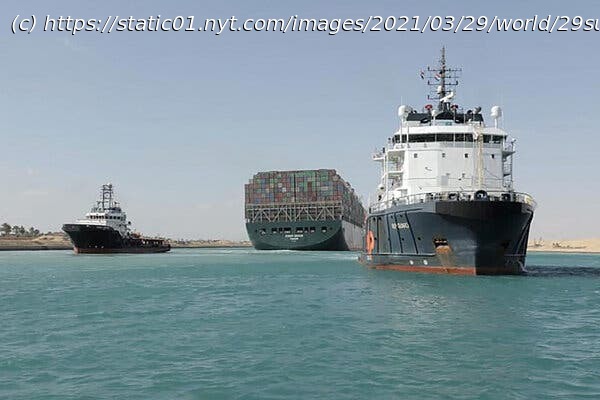A single stuck ship stymied global trade for nearly a week. That raises fundamental questions about risks in the supply chain industry.
For six days, billions of dollars’ worth of international commerce sat paralyzed at either end of the Suez Canal, stalled thanks to a single giant container ship apparently knocked sideways by a powerful southerly wind. The ship’s insurers and the canal authorities summoned the largest tugboats in the canal, then two even larger ones from further afield. They deployed diggers, front-end loaders and specialized dredgers to guzzle sand and mud from where the ship was lodged at both ends. They called in eight Dutchmen from the world’s most respected maritime salvage team. Day and night, with international pressure bearing down, the dredgers dredged and the tugboats tugged. But not until the seventh day, after the confluence of the full moon and the sun conjured an unusually high tide, did the ship wriggle free with one last heave shortly after 3 p.m., allowing the first of the roughly 400 ships waiting at either end of the canal to resume their journeys by Monday evening. In the aftermath of one of the most consequential shipping accidents in history, the global supply chain industry will have a cascade of costly delays to contend with and much to assess: the size of container ships, the width of the Suez Canal, the wisdom of relying on just-in-time manufacturing to satisfy consumer demand around the world, and the role, if any, of human error. But some things were out of anyone’s hands: If the wind and the tide might not be deemed acts of God by the insurance companies, they were a reminder that 21st-century commerce remains subject to random acts of nature. “We’ve all seen the pictures and thought, ‘How on earth does that happen?’” said Emily Hannah Stausboll, a shipping analyst at BIMCO, a large international shipping association. “People in the industry are asking: Could it happen again? And if so, what do we do to avoid it happening for another week next time?” How it happened will be the province of teams of inspectors and investigators who were set to begin work after the now-unstuck container ship, the Ever Given, motored under its own power Monday evening into the Great Bitter Lake, north of where it had been marooned since running aground amid a sandstorm last Tuesday morning. Because the ship sails under a Panamanian flag, Panama will handle the investigation unless Egypt exercises its right to take over, though international pressure for a more thorough accounting could result in the United States National Transportation Safety Board stepping in, said Capt. John Konrad, who founded gCaptain.com, a maritime news site. The Egyptians have already reached one conclusion, investigation or no. “The Suez Canal is not at fault,” Lt. Gen. Osama Rabie, the head of the canal authority, said at a news conference on Monday night. “We have been harmed by the incident.” Early on, the ship’s owner and operator blamed the wind, and maritime experts agreed that it had been a factor, perhaps the deciding one, as gusts pushed against the vertical wall of containers piled high atop the Ever Given as though against a sail.






